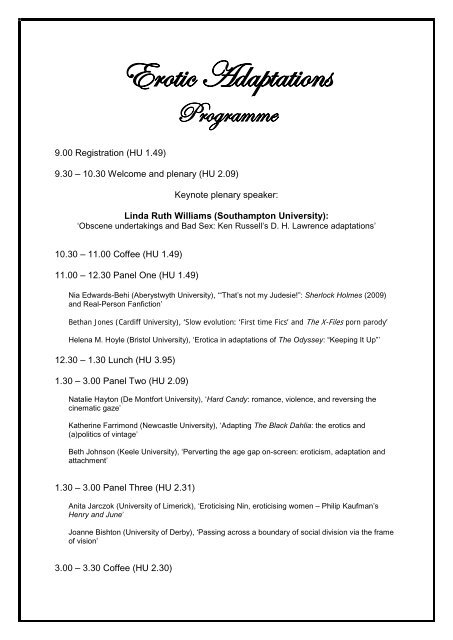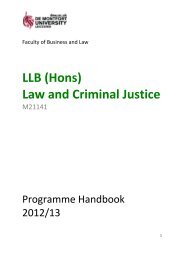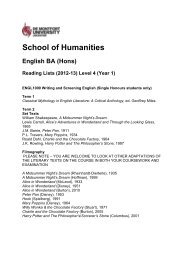Erotic Adaptations Programme - De Montfort University
Erotic Adaptations Programme - De Montfort University
Erotic Adaptations Programme - De Montfort University
You also want an ePaper? Increase the reach of your titles
YUMPU automatically turns print PDFs into web optimized ePapers that Google loves.
9.00 Registration (HU 1.49)<br />
<strong>Erotic</strong> <strong>Adaptations</strong><br />
<strong>Programme</strong><br />
9.30 – 10.30 Welcome and plenary (HU 2.09)<br />
Keynote plenary speaker:<br />
Linda Ruth Williams (Southampton <strong>University</strong>):<br />
‘Obscene undertakings and Bad Sex: Ken Russell’s D. H. Lawrence adaptations’<br />
10.30 – 11.00 Coffee (HU 1.49)<br />
11.00 – 12.30 Panel One (HU 1.49)<br />
Nia Edwards-Behi (Aberystwyth <strong>University</strong>), ‘“That’s not my Judesie!”: Sherlock Holmes (2009)<br />
and Real-Person Fanfiction’<br />
Bethan Jones (Cardiff <strong>University</strong>), ‘Slow evolution: ‘First time Fics’ and The X-Files porn parody’<br />
Helena M. Hoyle (Bristol <strong>University</strong>), ‘<strong>Erotic</strong>a in adaptations of The Odyssey: “Keeping It Up”’<br />
12.30 – 1.30 Lunch (HU 3.95)<br />
1.30 – 3.00 Panel Two (HU 2.09)<br />
Natalie Hayton (<strong>De</strong> <strong>Montfort</strong> <strong>University</strong>), ‘Hard Candy: romance, violence, and reversing the<br />
cinematic gaze’<br />
Katherine Farrimond (Newcastle <strong>University</strong>), ‘Adapting The Black Dahlia: the erotics and<br />
(a)politics of vintage’<br />
Beth Johnson (Keele <strong>University</strong>), ‘Perverting the age gap on-screen: eroticism, adaptation and<br />
attachment’<br />
1.30 – 3.00 Panel Three (HU 2.31)<br />
Anita Jarczok (<strong>University</strong> of Limerick), ‘<strong>Erotic</strong>ising Nin, eroticising women – Philip Kaufman’s<br />
Henry and June’<br />
Joanne Bishton (<strong>University</strong> of <strong>De</strong>rby), ‘Passing across a boundary of social division via the frame<br />
of vision’<br />
3.00 – 3.30 Coffee (HU 2.30)
3.30 – 5.00 Panel Four (HU 2.09)<br />
Thomas Watson (Northumbria <strong>University</strong>),, 'There's something rotten in the state of Texas:<br />
exploitation, adaptation and The Texas Vibrator Massacre’<br />
Johnny Walker (<strong>De</strong> <strong>Montfort</strong> <strong>University</strong>), ‘The Lust Continent: when British horror and hardcore<br />
come together’<br />
Xavier Mendik (Brunel <strong>University</strong>) ‘That’s l’amorte: Joe D’Amato and the Sadean art of love’<br />
3.30. – 5.00 Panel Five (HU 2.31)<br />
Vasileios Kantas (London South Bank <strong>University</strong>), ‘Photographic renditions of<br />
sexuality drawn from literary sources’<br />
Anthony McKenna (<strong>University</strong> of the West of England), ‘International production, sexual politics<br />
and the Confessions reboot that never was’<br />
5.00 – 6.00 (HU 2.09) Closing plenary
Abstracts<br />
Joanne Bishton (<strong>University</strong> of <strong>De</strong>rby):<br />
‘Passing across a boundary of social division via the frame of vision.’<br />
The mainstreaming of marginal, lesbian experience may beg the audience to consider whether<br />
aspects of subversion are in danger of being sacrificed for conservative consumerism. In this regard,<br />
screen representations of same-sex desire, those that highlight and engage with lesbian erotica, often<br />
challenge the notion of the gaze. The subject is often forced to confront and negotiate a balance<br />
between making visible sexual experience, whilst resisting the patriarchal signifiers that have been<br />
responsible for making them invisible in the first instance. In addition, feminist arguments surrounding<br />
the production of pornography become more complex and wide ranging when they are queered.<br />
Postmodernism has, in many ways, liberated the female form from such constraints. Yet, it has also<br />
to be acknowledged that whilst displays of lesbian subjectivity may connect with a lesbian audience<br />
and provide a viable alternative to heteronormativity, implications foreground by such ideas as<br />
Barthes’ ‘<strong>De</strong>ath of the Author’ intrinsically have the ability to undermine, rather than safeguard such<br />
erotic expressions. This paper will seek to illustrate how the appropriation of Sarah Waters’ Tipping<br />
the Velvet by screenwriter Andrew Davies and director Geoffrey Sax, promotes lesbian erotica to a<br />
popular audience, whilst contesting and resisting phallocentric interpretation.<br />
Katarzyna Bronk (Adam Mickiewicz <strong>University</strong>Poznań, Poland):<br />
‘Porndystopias: Laurence Dunmore's readings of Earl of Rochester’s (?) Sodom, or<br />
the Quintessence of <strong>De</strong>bauchery (1670)’<br />
John Wilmot, Earl of Rochester brought to light all the dirt, hypocrisy and moral double-facedness of<br />
the second half of the seventeenth-century. Sodom, or the Quintessence of <strong>De</strong>bauchery is attributed<br />
to him, though somewhat by way of wishful thinking, because of its am/immoral plot, ‘in-your-face’<br />
sexual imagery and shameless (and shamefully realistic) dramatization of hedonistic pleasures of<br />
Restoration bisexual culture. For the same reasons the play was not performed till 2001, though<br />
privately read by Rochester's contemporaries.<br />
When Laurence Dunmore filmed the biography of John Wilmot, The Libertine (2004), he<br />
imagined the play performed in front of Charles II. In his very short adaptation, constituting only a few<br />
minutes of the film, Dunmore made it thoroughly political, offering the viewers the easiest<br />
interpretation of the play. Showing Sodom as a political comment on the reign of Charles II, he<br />
silenced the misogynistic message of the original play. This paper argues that the original vision<br />
Rochester's satire unmasked was a sodomian U/Dystopia that unbosomed masculine anxieties<br />
concerning female domination, unproductive homosexual sex and the mechanization of bodily<br />
pleasures. Furthermore, it aims at showing how the utterly antifeminist reading of the farce would<br />
contribute to Dunmore's presentation of Restoration England and the infamous Rochester himself.<br />
Nia Edwards-Behi (Aberystwyth <strong>University</strong>):<br />
‘”That’s not my Judesie!”: Sherlock Holmes (2009) and Real-Person Fanfiction’<br />
1971 saw the release of the first published story that involved the depiction of Holmes and Watson as<br />
lovers, in the form of The Sexual Adventures of Sherlock Holmes. Often considered one of the first<br />
fandoms, Sherlock Holmes slash fan fiction has been available in abundance, from paper fanzines<br />
and more recently in internet communities. I wish to look at the most recent film incarnation of the<br />
detective and the doctor, the 2009 film directed by Guy Ritchie. I will explore the interplay between the<br />
canon text, the film text, and the slash fan fiction to have arisen from it. Most specifically, however, I<br />
wish to examine the real-person fan fiction that has emerged involving the cast of the film,<br />
predominantly Robert Downey Jr. and Jude Law, and the ways in which the roles assigned given<br />
characters within the slash fanfiction has influenced upon the relationships in the real-person<br />
fanfiction. Additionally, I wish to examine the possible ways in which the interaction between Downey
Jr. and Law in promoting the film has encouraged a reading of Holmes and Watson as lovers, and in<br />
turn how this has impacted upon the real-person fanfiction.<br />
Katherine Farrimond (Newcastle <strong>University</strong>):<br />
‘Adapting The Black Dahlia: the <strong>Erotic</strong>s and (A)politics of Vintage’<br />
The Black Dahlia (2006), Brian <strong>De</strong> Palma’s adaptation of the James Ellroy novel of the same name,<br />
presents a fictionalised version of the investigation of the murder of Elizabeth Short in 1940s Los<br />
Angeles. The film is notable for its glossy retro style and the relative absence of gore, despite the<br />
brutality of Short’s murder. In this paper, I will outline the implications of the film’s addition of a series<br />
of erotic artefacts in the form of black and white movie reels featuring Short before her death,<br />
suggesting that this revisioning of history functions as a form of ‘retrovision’ (Cartmell, Hunter and<br />
Whelehan, 2001). I argue that the revisionist style of these movie reels serves as an alignment of<br />
Short with the aesthetics of the ‘new burlesque’ (Ferreday, 2008). This foregrounding of the black and<br />
white footage exoticises Short’s vintage credentials, while sidelining any real markers of misogynistic<br />
violence. Drawing on <strong>De</strong>borah Jermyn’s analysis of the role of the female corpse in addressing issues<br />
of brutality against women in contemporary cinema (2004), I argue that The Black Dahlia’s adaptation<br />
of both Ellroy’s novel and Short’s death refuses the subversive potential of the female corpse, and<br />
instead holds Elizabeth Short up as an apolitical erotic spectacle.<br />
Natalie Hayton (<strong>De</strong> <strong>Montfort</strong> <strong>University</strong>):<br />
‘Hard Candy: romance, violence, and reversing the cinematic gaze’<br />
Little Red Riding Hood has long been accepted as a parable of rape with many adaptations focusing<br />
on transforming the story into one of positive female sexual expression where the heroine is often<br />
equal to the wolf in terms of desire. This paper will explore the erotic construction of Red and the wolf,<br />
where both are objects and subjects of conflicting and disturbing sexual ideologies, through a case<br />
study of David Slade’s film Hard Candy (2005). The production provoked an angry response from<br />
male audience members at its premiere at the Sundance Film Festival allegedly due to its castration<br />
scene. However, I would argue that in a production where the audience is dared to perceive a minor<br />
as sexually knowing, and where the “wolf” is portrayed in a sexually passive and tortured position,<br />
there is within this response a more complex erotic problem. In reversing the dynamics of Red and<br />
the wolf the film engages with Laura Mulvey’s seminal work on the cinematic gaze which focuses on<br />
the to-be-looked-at-ness of the female body and Carol Clover’s work on the tortured eroticised female<br />
form in the horror film. The trend to depict Red as the femme-fatale has always been popular, and<br />
while in some recent productions this predictably articulates a fear of “monstrous” female sexuality, as<br />
an unconscious appropriation Hard Candy challenges our in/ability to distinguish between eroticism<br />
and torture, violence, and romance.<br />
Helena M. Hoyle (Bristol <strong>University</strong>):<br />
‘<strong>Erotic</strong>a in adaptations of The Odyssey: ‘Keeping it up’<br />
‘I put my arms around him yes and drew him down to me so he could feel my breasts all perfume yes<br />
and his heart was going like mad and yes I said yes I will Yes.’ These are the words of Molly Bloom in<br />
a moment of rapture at the end of James Joyce’s Ulysses. The reader is enticed into an image of<br />
Odysseus and Penelope in their bed during a moment of passion, Odysseus’ homecoming; the climax<br />
of the epic. Many modern appropriations of The Odyssey contain an element of the erotic, or the<br />
explicit: why is this? Why do we want to see Odysseus in flagrante? Using examples from fan fiction,<br />
the graphic novel Tank Girl: The Odyssey and James Joyce’s Ulysses I will explore the motivation<br />
behind these sexually explicit versions of The Odyssey and their effect on its position in the canon. To<br />
aid this exploration, I will be drawing heavily on Roland Barthes’ The Pleasure of the Text, and its<br />
theorization on the eroticism of reading, in order to argue that sexually explicit depictions of Odysseus<br />
express our desire to keep him potent, and in an intimate position in the canon.
Russ Hunter (Northumbria <strong>University</strong>)<br />
‘1001 horrifically erotic nights: the political economy of the Italian exploitation film<br />
and genre adaptation’<br />
Banned in many countries for long periods of time and playing a central role in the Video Nasties<br />
phenomenon in the UK, from the 1970s onwards the Italian horror film has long attracted a great deal<br />
of controversy. The controversy surrounding their involvement in a moral panic sedimented their<br />
reputation as both trashy and potentially dangerous objects, leading them to be linked to popular<br />
notions of the potentially dangerous ‘effects’ of watching high-gore-content horror. Those few articles<br />
that have examined the Italian horror film in any detail have tended to use psychoanalysis in order to<br />
explore a perceived troublesome underlying gender politics. However, little work has been done in<br />
examining the political economy of the late-period Italian horror film. In this sense the adaptation of<br />
two commercially successful genres – horror and pornography – into a short-lived horror-porn generic<br />
hybrid at the end of the 1970s, most notably encapsulated in Joe D’Amato’s <strong>Erotic</strong> Nights of the Living<br />
<strong>De</strong>ad, offers an interesting example of genre adaptation motivated by the logic of exploitation cinema.<br />
This paper will therefore examine the ways in which D’Amato’s work, in attempting to combine the<br />
commercially successful aspects of these two genres, represents the ultimate conclusion of the logic<br />
of Italian exploitation cinema – the coupling of high-gore horror with hardcore pornography.<br />
Anita Jarczok (<strong>University</strong> of Limerick):<br />
‘<strong>Erotic</strong>ising Nin, eroticising women – Philip Kaufman’s Henry and June’<br />
Henry and June directed by Philip Kaufman and released in 1990 is based on Anaїs Nin’s<br />
unexpurgated diary under the same title. Kaufman’s creation was the first film which got NC-17 rating<br />
in America. This sparked many controversies, and, as result, the film got extra publicity in the press<br />
which hotly debated the change of the rating system. Anaїs Nin and the posthumous publication of<br />
the first volume of the unexpurgated diary, Henry and June, in 1986, was just as controversial: Nin’s<br />
carefully shaped image, which she put forward during her lifetime, collapsed. In my paper, rather than<br />
asking how faithfully Nin’s life is represented in Kaufman’s film and how closely the film follows Nin’s<br />
Henry and June, I propose to investigate these three questions: What is the role of the film in<br />
constructing Nin’s public image?; How does eroticising Nin in the film affect her image as a writer?;<br />
and a broader one, Does Kaufman’s representation of women and sexual acts reinforce or challenge<br />
certain stereotypes connected with femininity and sexuality? In order to answer these questions, I<br />
examine some of Kaufman’s choices: firstly, his choice to concentrate on this particular period of Nin’s<br />
life; secondly, the way he creates Anaїs Nin as a character; thirdly, the frequent display of naked<br />
female bodies, and finally his construction of sexual scenes.<br />
Beth Johnson (Keele <strong>University</strong>):<br />
‘Perverting the age-gap on-screen: eroticism, adaptation and attachment’<br />
Focusing on the themes of age and perversion, this paper will argue that that the appropriation of<br />
eroticism in Cédric Kahn’s filmic text L’ennui (1998), functions through the perverse representation of<br />
age-gap relationships. Adapted from Alberto Moravia’s classical text La noia (1960) or The Empty<br />
Canvas, Kahn’s text foregrounds age-gap attachments as excruciatingly erotic, elusive and<br />
obsessional. Analysing the interrelations between the characters Cécilia (Sophie Guillemin), Martin<br />
(Charles Berling), Cécilia’s father, (Maurice Antoni) and Meyers (Robert Kraymer), Kahn’s adaptation<br />
makes visible both the emotional disconnections that can occur in age-gap relationships as well as<br />
drawing upon the frisson of age-gap perversity. Exploring age-gap expectations, I argue that while<br />
L’ennui replicates the coda of eroticism associated with the visual image of young women and older<br />
men often found in pornographic texts, Kahn’s text situates teenage Cécilia as a mechanised sexobject<br />
only in order to pervert the erotic expectations of the audience. Moreover, Kahn seeks to<br />
problematise the positioning of erotic desire in an avant garde age of both boredom and excess.<br />
Invoking stylistic echoes of Last Tango in Paris (Bertolluci, 1972), erotic perversion is remapped<br />
through the themes of emotional disconnection and sexual anti-climax.
Vasileios Kantas (London South Bank <strong>University</strong>)<br />
‘Photographic renditions of sexuality drawn from literary sources’<br />
My paper aspires to present some photography-based works that deal with subjects drawn from<br />
sexuality-driven literature. Starting with my own practice, I will refer to my endeavour to visualize<br />
some personages mentioned by Michel Foucault in his work upon The History of Sexuality. As he<br />
suggests, a disciplinary power which society exerted over its members caused repression of the<br />
corporeal needs and desires. Specific mechanisms of knowledge and power centering on sex, as the<br />
hysterization of women’s bodies, the pedagogization of children’s sex, the socialization of procreative<br />
behaviour, and the psychiatrization of perverse pleasure, produced specific identity types. These<br />
human types, stigmatized for their abnormal sexuality, are protagonists in my series and<br />
are refashioned and relocated in contemporary era. The paper will discuss directorial strategies of<br />
rendering visible characters that have been initially shaped on a written form.<br />
Anthony McKenna (<strong>University</strong> of the West of England):<br />
‘International production, sexual politics and the Confessions reboot that never was’<br />
The Confessions series of the 1970s was a hugely successful British sex-comedy franchise. The<br />
books were written by Christopher Wood, published under the pseudonym Timothy Lea, and spawned<br />
a series of four films which, in turn, inspired many rip-offs and cash-ins. Though hugely successful at<br />
the time, the films were critically derided upon release and are still often used by film scholars and<br />
historians to represent the low water mark of British cinema in the difficult 1970s. In the 1980s,<br />
Michael Klinger – executive producer of the original films – unsuccessfully sought to revive the<br />
franchise, and the attempt to adapt the Confessions series to fit the morals and mores of the 1980s is<br />
the subject of this paper. The original Confessions series, though funded and distributed by a major<br />
American studio – Columbia – sought to appeal to a peculiarly British sensibility. By contrast, the<br />
1980s attempted reboot sought to internationalise their appeal by making the protagonist American<br />
and setting the film in Australia. Also, correspondence related to the project shows that the producers<br />
wanted the new adaptations to reflect not only a post-feminist world, but also contemporary concerns<br />
about HIV/AIDS by following the widespread industry practice of privileging romantic love over sexual<br />
adventures. With research drawn from extensive consultation of Michael Klinger’s personal papers,<br />
the paper will investigate the difficulties of attempting to re-adapt bawdy British comedies for an<br />
international audience at a time when sexual behaviour on-screen was subject to controversy and<br />
considerable self-censorship.<br />
Xavier Mendik (Brunel <strong>University</strong>):<br />
‘That’s l’amorte: Joe D’Amato and the Sadean art of love’<br />
Up until his death in 1999, Joe D’Amato (AKA Aristide Massaccesi), remained one of Italy’s most<br />
controversial bad-boys of cult cinema. <strong>De</strong>spite working in a variety of genres from horror to<br />
pornography, post-apocalypse science fiction to neo-noir/soft-core thriller, an unsettling eroticisation<br />
of death and decay remained the consistent theme throughout the director’s work. At his most<br />
controversial, D'Amato pioneered a series of bizarre ‘sex and death’ genre-hybrids such as Le Notti<br />
<strong>Erotic</strong>he <strong>De</strong>i Morti Viventi (<strong>Erotic</strong> Nights of the Living <strong>De</strong>ad [1979]) and Holocausto Porno (Porno<br />
Holocaust [1980]), in which a European woman is forced to have anal sex with a third-world zombie.<br />
Although Joe D’Amato´s later hard-core productions of the 1980s and 1990s (such as X-Hamlet<br />
[1994], Barone Von Masoch [1994] and Tarzan-X: Shame Of Jane [1994]), seem to share little<br />
connection with the director’s earlier, controversial output, this paper uses recent re-readings of Sade<br />
to explore an essential continuity between D’Amato’s controversial 1970s works and these later<br />
pornographic epics, exploring the extent to which they share a controversial continuity via an<br />
emphasis on horrific regimes of punishment, suffering and male sexual exhibitionism. By analysing<br />
the two D’Amato films 120 Days of the Anal and The Marquis <strong>De</strong> Sade (both 1995), it shall be argued<br />
that these later films not only use the motif of the sexual libertine as a narrative agent, but retain<br />
stylistic and repetitive structures that also draw parity with both D’Amato’s earlier controversial works<br />
and Sade’s fiction. Adapting recent re-readings of the politics of sexual difference depicted in Sade’s<br />
work, I shall also argue that D’Amato movies also disrupt totalised and empowered visions of
masculinity, which shall be considered through an analysis of D’Amato’s use of the Italian porn icon<br />
Rocco Siffredi.<br />
Johnny Walker (<strong>De</strong> <strong>Montfort</strong> <strong>University</strong>):<br />
‘The Lust Continent: when British horror and hardcore come together’<br />
A now famous essay written by Julian Petley (1986) shed light on an area of British cinema that had,<br />
up until then, been ignored by most film critics. This “repressed side of British cinema”, what Petley<br />
would refer to as ‘the lost continent’, constituted “a dark, disdained thread […] crossing authorial and<br />
generic boundaries” that was “always received critically with fear and disapproval.” Since the 1990s,<br />
however, a lot of time has been spent within the academy ‘rediscovering’ these films, with large<br />
volumes such as Rigby’s English Gothic (2002) and Steve Chibnall’s Quota Quickies (2009) stressing<br />
the vibrancy and richness of this previously repressed terrain. However, it remains a truism today that<br />
‘other’ contemporary British cinemas (that even Petley didn’t acknowledge) which came to<br />
prominence in the 90s, such as the amateur film and – what this paper will be focussing on –<br />
pornography, remain marginal to (and in many cases void from) any academic discussion on British<br />
National Cinema. With this in mind, and by using the British hard-core parodies of Dracula – Cathula<br />
and Cathula II – as case studies, the present paper will interrogate the following questions. Firstly,<br />
how does a ‘rediscovered’ genre of British cinema – in our case, the horror film – fluidly interact with<br />
the still repressed genre of hard-core pornography, and what implications does this have on current<br />
academic discussion surrounding horror cinema, the arena of porn studies and issues of genre?<br />
Secondly, how do the Cathula films utilise narrative, when pornography is traditionally said to be<br />
devoid of such form and structure? Lastly, can the Cathula movies be considered as part of a British<br />
National Cinema, and if so, in what ways do they convey ‘Britishness’ onscreen and throughout their<br />
promotional material? My paper will show how horror and pornography (genres that are closely<br />
related due to their demands of the spectator) attain a particular resonance indebted to alleged British<br />
traditions of Gothic horror and the sex film. As such, via an analysis of editing and narrative, I will<br />
argue that the Cathula films might be seen to challenge pornography’s disrepute and present hardcore<br />
features as part of a national institution of cinematic practice.<br />
Thomas Watson (Northumbria <strong>University</strong>):<br />
'There's something rotten in the state of Texas: exploitation, adaptation and The<br />
Texas Vibrator Massacre'<br />
Although it is not necessarily a new phenomenon to address, the cinematic amalgamation of both<br />
Exploitation, Horror and Hardcore Pornography is an interesting one to examine in terms of<br />
representation and appropriation of specific generic conventions and iconography. In this instance,<br />
my paper will commence with an initial analysis of those films which came to surface amidst the<br />
American Exploitation surge within the 1970's, this perceivable era of 'Grindhouse Sleaze and Excess'<br />
producing some increasingly interesting examples of what can only be identified as Exploitative,<br />
Horror-Porn crossovers. Here, I will be thinking of the psychedelic occult porn movie Hardgore (Hugo,<br />
1974), and the rather obscure (and increasingly graphic) films of Shaun Costello (Forced Entry, 1972<br />
and Waterpower, 1974). Although these films will not form the principle basis for analysis, they are<br />
important in locating the emergence of graphic representations of Hardcore Sex and increasingly<br />
violent exploitation, issues which I believe to be addressed within The Texas Vibrator Massacre.<br />
Using the theories of Jay McRoy in his article 'Parts is Parts': Pornography, Splatter Films and the<br />
Politics of Corporeal Disintegration, I aim to examine the ways in which both the Hardcore Porn film<br />
and relevant examples from within the Horror and Exploitation sub-genres locate the cinematic body<br />
as being in a constant state of flux and fragmentation. In McRoy's terms, these films seem to 'reveal<br />
the body's corporeal and ontological boundaries as imaginary', the body itself susceptible to great<br />
levels of intrusion and ultimately destruction. However, these ideas posit these two distinctive (albeit<br />
increasingly conflating) genres as separate cinematic entities, grouping them together yet never fully<br />
realising their intertextual potential. The question I aim to address is what exactly is at stake when a<br />
text emerges that so efficiently merges these two genres together, moving outside normative generic<br />
definition and into issues of problematic representation. Does this perhaps present a doubling of
corporeal threat, the body violated through increasingly violent hardcore sex and then ultimately<br />
exposed to further degradation and brutal murder? Utilising and amalgamation of the respective<br />
theories of Linda Williams (in terms of pornographic representation) and Linda Hutcheon (with regards<br />
to adaptation), I aim to examine The Texas Vibrator Massacre as a cinematic appropriation of what<br />
has been regarded as a staple of cult exploitation (Hooper’s original ultimately garnering this accolade<br />
over time). I aim to discuss a certain tension that comes to emerge whereby a film produced within an<br />
era of excessive exploitation (although in which no real violence or excess is explicitly represented) is<br />
exploited within itself.














